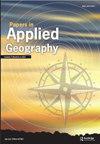Exploring Spatially Varying Relationships Between Preterm Birth and Socioeconomic, Demographic, and Behavioral Factors in Georgia, USA Using Geographically Weighted Logistic Regression
Q2 Social Sciences
引用次数: 0
Abstract
Abstract Preterm birth (PTB) is an important cause of infant morbidity and mortality around the world. A good understanding of its associations with relevant factors is essential for an effective reduction in PTB risk. This study explores the spatially varying relationships between PTB and demographic, socioeconomic, and behavioral factors in the state of Georgia, USA using Geographically Weighted Logistic Regression (GWLR). The results show the relationships between PTB and factors vary over space, and the spatial patterns in the varying relationships are related to the socioeconomic and urbanization characteristics of the communities where the births were located. For example, PTB has significant positive relationships with black mothers and single mothers, and significant negative relationships with maternal education in the majority of Georgia, but such relationships are insignificant in small portions of rural Georgia with low socioeconomic status (SES). PTB has significant positive relationships with maternal age and parity, and significant negative relationships with female births in small portions of Georgia, particularly in the Atlanta Metropolitan Area, while in larger portions of rural Georgia with overall low SES, those relationships are not significant. Thus, health prevention and intervention policies should be tailored to address the locally important factors to reduce PTB risk.使用地理加权逻辑回归探索美国乔治亚州早产与社会经济、人口统计学和行为因素之间的空间变化关系
摘要早产(PTB)是世界范围内婴儿发病和死亡的重要原因。充分了解其与相关因素的关系对于有效降低肺结核风险至关重要。本研究利用地理加权Logistic回归(GWLR)探讨了美国佐治亚州肺结核与人口、社会经济和行为因素之间的空间变化关系。结果表明:肺结核与各因素的关系存在空间差异,不同关系的空间格局与新生儿所在社区的社会经济和城市化特征有关。例如,在格鲁吉亚的大多数地区,产后肺结核与黑人母亲和单身母亲有显著的正相关关系,与母亲教育有显著的负相关关系,但这种关系在格鲁吉亚农村社会经济地位较低的一小部分地区不显著。在佐治亚州的一小部分地区,特别是在亚特兰大大都会地区,肺结核与产妇年龄和胎次有显著的正相关,与女性出生有显著的负相关,而在佐治亚州总体社会经济地位较低的农村地区,这些关系不显著。因此,卫生预防和干预政策应针对当地的重要因素,以降低结核病的风险。
本文章由计算机程序翻译,如有差异,请以英文原文为准。
求助全文
约1分钟内获得全文
求助全文

 求助内容:
求助内容: 应助结果提醒方式:
应助结果提醒方式:


